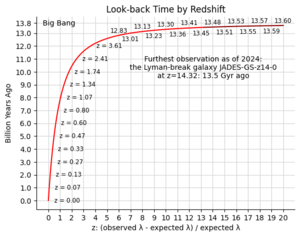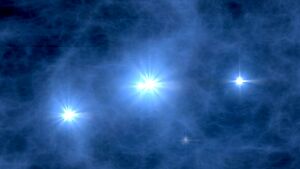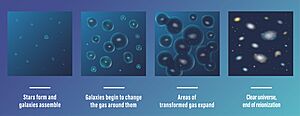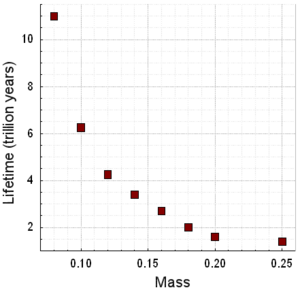Chronology of the universe facts for kids
The history of the universe tells us about how everything we know came to be, from the very beginning to what might happen far in the future. Scientists believe the universe started about 13.8 billion years ago.
Contents
How the Universe Changed Over Time

To make it easier to understand, we can divide the universe's story into five main parts:
The Universe's First Moments
This is about the first tiny fraction of a second (like a picosecond, which is 10−12 seconds). During this time, the rules of physics we know today might not have fully applied. The four main forces of nature—gravity, electromagnetism, the weak force, and the strong force—appeared one by one. The universe also grew incredibly fast in a burst called cosmic inflation.
Tiny wobbles in the universe during this time are thought to be the starting points for the huge structures we see much later, like galaxies. Scientists are still learning a lot about these very early moments.
The Young Universe
This period lasted for about 370,000 years. First, different kinds of tiny particles formed. Matter and antimatter particles appeared in almost equal amounts, but most of them destroyed each other. A small amount of matter was left over, which is what our universe is made of today!
Around one second, tiny particles called neutrinos stopped interacting with other matter. These neutrinos still exist today, forming a "cosmic neutrino background." If very old primordial black holes exist, they might have formed around this time too.
After a few minutes, conditions were right for nucleosynthesis, which is like a cosmic cooking process. About 25% of the protons and all the neutrons fused together to make heavier elements, mainly helium-4.
By 20 minutes, the universe was too cool for new fusion, but still too hot for neutral atoms to form. It was a thick, glowing fog of charged particles, like a plasma.
Around 370,000 years, the universe cooled enough for electrons to join with atomic nuclei, forming the first neutral atoms, mostly hydrogen and helium. This event is called "recombination." When these atoms formed, they released light. This light can still be seen today as the cosmic microwave background (CMB), which is the oldest direct picture we have of the universe!
The Dark Ages and First Structures
This time lasted from 370,000 years to about 1 billion years after the Big Bang. After the universe became transparent, it was still very dark because there were no stars or galaxies yet to make new light. The only light was the leftover glow from the CMB, which quickly faded into non-visible wavelengths. This period is known as the cosmic Dark Ages.
Around 200 to 500 million years, the very first stars and galaxies started to form. They were pulled together by invisible stuff called dark matter, which had already started clumping into huge webs. The earliest stars were probably enormous and didn't have many heavy elements. They lived short, bright lives and then exploded as supernovae, spreading new elements like carbon and oxygen throughout the universe. These elements are the building blocks for everything we see today.
Over time, groups of galaxies called galaxy clusters and superclusters began to appear. High-energy light from these early stars and galaxies also started to "reionize" the universe, splitting atoms back into charged particles. This period, called reionization, gradually ended around 1 billion years after the Big Bang. After this, the universe began to look more like it does today, though it was still denser and had more active star formation.
Scientists have observed galaxies that formed as early as 329 million years after the Big Bang using telescopes like the James Webb Space Telescope.
The Universe as We See It Today
From about 1 billion years ago until now, the universe has looked pretty much the same. It will continue to look similar for many billions of years into the future. Our own galaxy, the Milky Way, started to form about 8.8 billion years ago. Our Solar System formed about 4.6 billion years ago, and the first signs of life on Earth appeared about 3.5 billion years ago.
For a long time, gravity slowed down the universe's expansion. But about five or six billion years ago, something changed. The universe's expansion started to speed up again! Scientists believe this is due to a mysterious force called dark energy. Dark energy is now the biggest part of the universe, and it's making everything spread out faster and faster.
The Far Future and What Happens Next
Eventually, stars will stop being born, and the universe will become a darker place. The expansion of the universe will also mean that we will only be able to see our local galaxies. Scientists have different ideas about what will happen to the universe in the very, very distant future.
The Big Bang: The Beginning
The idea of the Big Bang is our best scientific explanation for how the universe began and how it has grown. It's based on Albert Einstein's theory of general relativity, which describes how gravity works.
If we use these theories to go back in time, they suggest a point where everything in the universe was incredibly close together, or even at a single point. This moment is called the Big Bang. It doesn't mean the universe exploded from one spot into empty space. Instead, space itself began to expand everywhere at once. That's why scientists say the Big Bang "happened everywhere."
Our current theories can't fully explain what happened at the exact moment of the Big Bang. We might need a new theory that combines gravity with quantum mechanics to understand it better. After that moment, all distances in the universe started to grow, and they are still growing today.
The Universe's Earliest Moments
During the very first moments, the universe was so extreme that our understanding is still developing. Some theories even suggest that the idea of "seconds since the Big Bang" might not fully apply in these earliest stages. This is an active area of research for scientists.
Even though there was a special period of super-fast growth called "inflation," the universe has always been expanding since the Big Bang. After inflation, the expansion slowed down for billions of years, but then it started speeding up again about 4 billion years ago because of dark energy.
The Planck Epoch
This is the very first moment, less than 10−43 seconds after the Big Bang. During this time, the universe was incredibly hot and dense. Scientists believe that all four fundamental forces—gravity, electromagnetism, the weak force, and the strong force—were combined into a single force. We don't fully understand the physics of this time because our current theories break down.
The Grand Unification Epoch
This period was between 10−43 and 10−36 seconds after the Big Bang. As the universe expanded and cooled, the forces of nature started to separate, like water turning into ice. First, gravity separated from the other combined forces. This left two forces: gravity and a combined "electrostrong" force. Scientists are still looking for evidence that this combined force existed.
This epoch ended when the electrostrong force split into two separate forces: the strong force and the electroweak force.
The Electroweak Epoch
This period started around 10−36 seconds after the Big Bang. During this time, the universe was still incredibly hot. The electromagnetic and weak forces were still combined.
Inflation: Super-Fast Growth
This happened before about 10−32 seconds after the Big Bang. During inflation, the universe expanded by an unbelievable amount—at least 1026 times bigger in every direction! Imagine something the size of a DNA molecule suddenly growing to be 10.6 light-years long in a tiny fraction of a second!
Scientists don't know exactly what caused inflation, but one idea is that a special "inflaton field" released a huge repulsive force, pushing space apart. Inflation helps explain why our universe is so smooth and uniform on large scales today, even though it started out very messy.
When inflation ended, the universe was filled with a hot, dense mix of tiny particles called quarks, anti-quarks, and gluons. The universe kept expanding, but at a slower rate. Then, about 4 billion years ago, it started speeding up again due to dark energy.
The Young Universe: Particles and Elements
After inflation, the universe was filled with a hot mix of particles. From this point on, we understand the physics much better because we can study similar conditions in particle accelerators on Earth.
Electroweak Symmetry Breaking
Around 10−12 seconds after the Big Bang, a very important event happened: electroweak symmetry breaking. This had two main effects:
- Through something called the Higgs mechanism, many elementary particles that had no mass suddenly gained mass.
- The weak nuclear force and the electromagnetic force, which were once combined, now became separate forces. The weak force became short-range, while electromagnetism remained long-range.
After this, all the fundamental forces we know today were in their present forms, and particles had their expected masses. But the universe was still too hot for stable particles like protons or neutrons to form.
The Quark Epoch
This period lasted from 10−12 seconds to 10−5 seconds after the Big Bang. The universe was a hot, dense "soup" of quarks, leptons, and their antiparticles. Collisions between particles were so energetic that quarks couldn't stick together to form larger particles.
This epoch ended when the universe cooled enough for quarks to combine and form hadrons, like protons and neutrons.
Baryogenesis: Why We Exist
Scientists believe that during this time, something caused a tiny imbalance between matter (like protons and neutrons) and antimatter. For some reason, a little bit more matter was created than antimatter. Most matter and antimatter destroyed each other, but this small leftover amount of matter is what makes up everything we see in the universe today!
The Hadron Epoch
This period was between 10−5 seconds and 1 second after the Big Bang. The universe cooled enough for quarks to form hadrons, including protons and neutrons. Most of the hadrons and anti-hadrons then destroyed each other, leaving a small amount of hadrons behind.
Scientists predict that for every 6 protons, about 1 neutron remained. This ratio is important because it matches the amounts of elements we see in the universe today.
Neutrino Decoupling
Around 1 second after the Big Bang, neutrinos stopped interacting with other matter and started traveling freely through space. These neutrinos still exist today, forming a "cosmic neutrino background." They are very hard to detect directly, but scientists have found indirect evidence for them by studying the cosmic microwave background.
The Lepton Epoch
This period lasted from 1 second to 10 seconds after the Big Bang. After most hadrons were gone, the universe was dominated by leptons (like electrons) and antileptons. Like the hadrons before them, most leptons and antileptons then destroyed each other, leaving a small amount of leptons.
The Photon Epoch
This period lasted from 10 seconds to 370,000 years after the Big Bang. After most other particles were gone, the universe's energy was dominated by photons (light particles). These photons constantly bumped into charged particles like electrons and protons, making the universe opaque, like a thick fog.
Making Light Elements: Nucleosynthesis
Between about 2 and 20 minutes after the Big Bang, the universe was hot and dense enough for nuclear fusion to happen. This created the nuclei of a few light elements beyond hydrogen, like helium-4 and small amounts of deuterium (a type of hydrogen) and lithium.
The universe cooled too quickly for heavier elements to form. By mass, the early universe was about 75% hydrogen and 25% helium. The amounts of these elements we see in old galaxies today are strong evidence for the Big Bang theory.
Matter Takes Over
Around 47,000 years after the Big Bang, the universe's behavior changed. Before this, light and other fast-moving particles controlled how the universe expanded. But now, matter (like atomic nuclei) became the main influence.
At this stage, about 84.5% of the matter in the universe was cold dark matter, and 15.5% was "ordinary" matter. Dark matter doesn't interact with light, but its gravity pulls things together. This helped structures like galaxies form much faster than they would have otherwise. Dark matter formed huge, spread-out webs, and ordinary matter then gathered in these denser areas.
Recombination and the Cosmic Microwave Background (CMB)
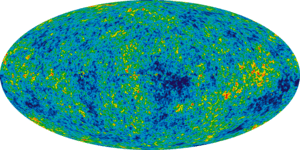
About 370,000 years after the Big Bang, two important things happened:
1. Recombination: The universe cooled enough for free electrons to combine with atomic nuclei, forming the first neutral atoms (mostly hydrogen and helium). Before this, the universe was a hot, opaque plasma. 2. Photon Decoupling: When these neutral atoms formed, their electrons settled into lower energy states, releasing photons (light particles). These photons were no longer constantly bumping into charged particles, so they could travel freely through space.
This meant the universe became transparent for the first time! The light released during this time, initially a pale orange glow, has been stretched by the universe's expansion over billions of years. It's now redshifted into radio waves, which we detect as the cosmic microwave background (CMB). The CMB is like a "baby picture" of the universe, showing us what it looked like when it was only 370,000 years old.
The Dark Ages and First Stars
This period lasted from 370,000 years to about 1 billion years after the Big Bang.
The Dark Ages
After recombination, the universe was transparent but very dark. There were no stars or galaxies yet to produce light. The temperature cooled from about 4000 K to 60 K. The only light was the fading CMB and faint radio waves from hydrogen atoms. For hundreds of millions of years, the universe was truly dark.
The first stars, called Population III stars, started to form a few hundred million years after the Big Bang. These stars were the first new sources of visible light in the universe. As more stars and galaxies formed, the Dark Ages gradually came to an end.
Oldest Observations
Telescopes like the Hubble Space Telescope and the James Webb Space Telescope are designed to look back in time and find these very first galaxies. The James Webb Space Telescope can see objects that formed as early as 180 million years after the Big Bang!
First Stars and Galaxies Emerge
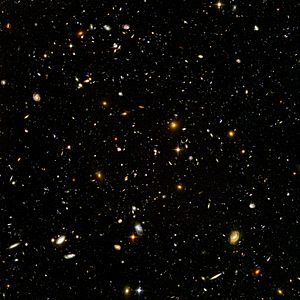
Dark matter continued to pull together into huge, spread-out webs. Ordinary matter then gathered in these denser areas, forming clouds of hydrogen gas. These gas clouds eventually collapsed to form the first stars and galaxies. Where many galaxies formed, they eventually grouped into galaxy clusters and superclusters.
The first stars (Population III stars) were responsible for creating heavier elements from the hydrogen and helium made in the Big Bang. These huge stars lived short lives and exploded, spreading these new elements throughout the universe. This marked the beginning of the "Stelliferous Era," the time when stars exist.
Scientists are still actively researching when exactly the first stars, galaxies, and supermassive black holes formed. Observations from telescopes like Planck suggest that the first stars might have formed around 300 million years after the Big Bang.
Reionization
As the first stars, small galaxies, and quasars (very bright early galaxies with active black holes) formed, they emitted intense radiation. This radiation reionized much of the surrounding universe, splitting the neutral hydrogen atoms back into a plasma of free electrons and protons. This was the first time the universe was reionized since recombination.
Scientists study light from distant quasars to understand reionization. This light shows how much neutral hydrogen was present at different times. Reionization started as "bubbles" of ionized hydrogen that grew larger over time. It began around 250 million years and was mostly complete by 1 billion years after the Big Bang.
Even though the universe was reionized, it remained largely transparent because the matter was much more spread out due to expansion.
Galaxies, Clusters, and Superclusters
Matter continued to gather under gravity, forming galaxies. Stars like our Sun (called Population I stars) formed later within these galaxies. Gravity also pulled galaxies together to form groups, clusters, and superclusters. Observations show that many small galaxies merged to form larger ones in the early universe.
The Universe as It Appears Today
The universe has looked pretty much the same for many billions of years, and it will continue to look similar for many more. Our Milky Way galaxy's main disk formed about 8.8 billion years ago.
The Dark Energy-Dominated Era
Around 9.8 billion years after the Big Bang, the universe's behavior changed again. For a long time, gravity had been slowing down the expansion. But now, observations show that the expansion of the universe slowly started to speed up again.
Scientists believe this acceleration is caused by dark energy. Dark energy is a mysterious form of energy that we can't see directly, but we can see its effect on the universe. It acts like a constant force pushing space apart. As the universe expands, matter and gravity become less influential, but dark energy's effect stays strong. This is why the universe's expansion is now accelerating. Dark energy is thought to make up about 68.3% of all the mass and energy in the universe.
The Far Future and What Happens Next
Scientists have different ideas about what will happen to the universe in the very distant future. The outcome depends on things like the exact amount of dark energy and whether protons (parts of atoms) can decay.
If the universe keeps expanding, eventually all but the closest galaxies will be carried away so fast that we won't be able to see them anymore. In the very, very long term (after trillions of years), the "Stelliferous Era" (the time when stars are born and shine) will end. Stars will stop forming, and even the longest-lived stars, like red dwarfs, will eventually die.
Beyond that, all objects in the universe will cool down and slowly break apart into tiny particles and very low-energy light. Here are some of the main ideas for the universe's ultimate end:
- Heat Death: The universe keeps expanding, getting bigger, colder, and emptier. Eventually, everything breaks down into tiny particles and light, and there's no more energy left to do anything. It's like everything just fades away.
- Big Rip: The expansion of space speeds up so much that it eventually tears apart everything, even atoms and the fabric of space itself.
- Big Crunch: This is the opposite idea. The expansion would eventually stop and then reverse, causing the universe to shrink back down into a hot, dense state. However, current observations suggest this is unlikely.
- Vacuum Instability: This is a very strange idea. It suggests that the "empty" space we live in might not be truly stable. It could suddenly collapse into a different, more stable state. If this happened, all the forces and particles we know would change, and everything in the universe would be destroyed and reformed into something completely different.
On these incredibly long timescales, very rare quantum events that we almost never see today might become common, leading to unpredictable changes in the universe.
See also
 In Spanish: Historia del universo para niños
In Spanish: Historia del universo para niños
- Age of the universe
- Cosmic Calendar (the universe's age scaled to a single year)
- Cyclic model
- Dark energy
- Graphical timeline from Big Bang to Heat Death
- Graphical timeline of the Big Bang
- Graphical timeline of the Stelliferous Era
- Timeline of the early universe
- Timeline of the far future
- Ultimate fate of the universe



